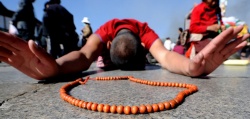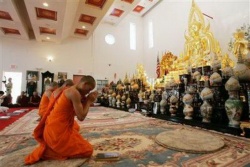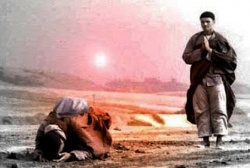Why do Buddhists bow? What purpose does it serve?
Bowing is a common practice in Asia, both within and outside religious circles, a way of expressing respect and reverence, as well as a form of greeting. In India, for example, people bow and say namaste, which means "I bow to honor the divine within you." It is a salutation that recognizes the spirit, like the Hebrew word "shalom," and is used for both coming together and parting. In Tibet, we bow and say [[tashi delek[[, meaning "excellent luck and auspicious good fortune to you." Disciples and devotees bow to their teachers, gods, and holy icons (called murtis--images in Tibetan). In India, Hindus kneel or prostrate themselves on the floor, often at their guru's feet, in a gesture known as pranam.
Buddhists commonly offer bows when entering or leaving a temple, shrine, pilgrimage place, or spiritual circle of any kind. Zen Buddhists use a short form of the bow, simply placing their palms together at the heart chakra and inclining the torso; this is called gassho in Japanese. My Zen master in Kyoto explained that bringing the two hands together at the heart represents the reunion of all polarities and duality in our spiritual center, the heart of enlightenment.
A heartfelt bow is not an empty gesture. Bowing is a yoga-like practice with many different levels of meaning. Bowing is a way of being, a way of giving, of offering up and opening oneself. My teachers taught me to drop whatever I was holding on to, put my hands together at my heart, and bow to all beings seen and unseen, thus cherishing and respecting all forms of life. This is a practice of what Mahatma Gandhi called ahimsa, which means "truth in nonviolence." Bowing helps us to be centered in the present moment and become more uncomplicated, vulnerable, and humble.
I didn't always enjoy bowing as much as I do now. When I first lived in the Himalayas in the early 1970s, the idea of prostrating before someone or before a graven image was anathema to me. "I won't lower myself to anyone!" I thought. Eventually, I learned to enjoy bowing, and discovered how profound and beautiful a practice it is.
Now I see bowing as an elegant traffic signal of the body, voice, and mind. Every bow says: Slow down. Drop the ego. Meditation zone ahead. Proceed with cushion. Bowing is a mindfulness practice. It is a way of removing our mental and emotional armor, along with other ego baggage we may be burdened with. It is like leaving our shoes and luggage at the door of a shrine.
The seventh-century Indian Buddhist master Shantideva, whose name means "the gentle angel" and who wrote the classic Mahayana text "Entering the Path of Enlightenment," said that just to raise one hand in a gesture of respect and reverence sows the seed of enlightenment. Since that time, bowing has become an intensive spiritual exercise for Buddhists. The devout get down on their hands and knees and then lower themselves face down and flat on the floor; this is a full bow, called a prostration. This gesture symbolizes yielding, surrender, reverence, and taking refuge in that which is good, true, and holy. In fact, this outer form of reverence simply reflects an inner gesture of awareness and is not very meaningful unless done in that spirit.
Prostrations such as these are an important part of the most common foundational practices of Tibetan Buddhism (or Vajrayana), called ngondro (literally, "preliminary practices"). Over the course of several months or more, the beginning practitioner is expected to complete at least 111,000 of these full-body prostrations, along with chanted Refuge Prayers (the ngondro practices also include several hundred thousand others prayers, purification mantras, offerings, mandalas, and devotional meditations). This is considered an excellent practice and a means of purifying karma, which in turn provides a firm foundation for deeper Vajrayana meditation and yoga. It is also something Tibetan Buddhists continue to practice in fewer repetitions on a daily basis throughout their lives. I remember my aged Dzogchen master, the late Dudjom Rinpoche, doing full prostrations even into his 80s. My late Tibetan master, Kalu Rinpoche, explained that prostrating our five limbs on the ground reintegrates our separate sense of being into oneness with the original nature of the five elements--earth, water, fire, air, and space.
The truth is that completing these 100,000 prostrations, known as chak-boom in Tibetan, was one of the hardest things I've ever done in my life. My teachers had me complete ngondro three times during the 1970s and 1980s in order to fully receive Tantric transmission, and practice three different Vajrayana lineages. We did this for weeks and months at a time, 11 or 12 hours a day, from before dawn until after dark. It took some time to get used to it just on a physical level, but after a while the struggle of body and mind became subtler: Wrestling with dark and light, resisting or resenting the process, all began to fall away.
If three cycles of ngondro sounds like a lot, the 14th-century Tibetan saint Tsongkhapa is known to have performed over a million prostrations during his four-year meditation retreat in a cave; and the aged wife of a lama I know in Sikkhim has completed the ngondro practices 16 times!
Zen practitioners likewise offer large numbers of full prostrations to the Three Jewels--the Buddha, the dharma, and the sangha--in their meditation centers and monasteries. My Zen teacher used to offer 108 bows each morning before the large Buddha statue on the altar of his temple, even at an advanced age. And in all Buddhist traditions, three bows are offered when entering the presence of spiritual masters and teachers, acknowledging the presence of an embodiment of the principle of enlightenment.
Buddhist scripture tells us that the Buddha realized his great awakening while sitting beneath a tree in the wilderness of northern India at Bodh Gaya. According to the sutras, when he awoke on that auspicious day, the entire natural world bowed to him in gladness, recognition, and veneration. The earth trembled, and trees, flowers, and tall blades of elephant grass bent down in respect. We join in reverence and enter into that moment each time we bow.
The best bowing practice I know--and one I find eminently doable on a daily basis--is to simply raise joined palms before the heart and lower my head in a gesture of surrender and letting go. This silent bow is my favorite form of contemplative, wordless prayer.


